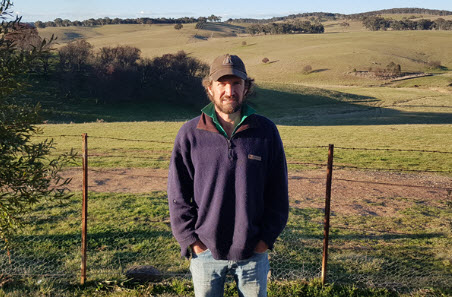Winter feed booster
30 August 2017

Potential winter pasture growth rate gains of up to 13kg/ha have been identified by Mandurama Young Farmer Group (MYFG) paddock demonstrations in the NSW tablelands this year.
Through the MLA Producer Demonstration Site (PDS) project, the group is investigating the effectiveness and costs of a range of nutrients and additives to lift pasture productivity and sheep growth rates during this traditional winter feed gap period.
MYFG member Tim Jamieson manages ‘Godolphin’ at Orange, owned by Tony Gordon, where one of the group’s five PDS demonstrations was established on phalaris-based pasture in June 2017.
The demonstration compared pasture treatments of:
- The naturally-occurring plant hormone, gibberellic acid, applied at a rate of 10g/ha (costing about $23/ha - including $8/ha for the gibberellic acid and $15/ha for contract application)
- A mix of gibberellic acid with liquid nitrogen (N) at a rate of 50L/ha (costing about $73/ha – including $50/ha for liquid N, $8/ha for the gibberellic acid and $15/ha for contract application)
- A control area with no treatment.
The same trial area will next year demonstrate the impact of adding the trace element molybdenum and a slow-release granular inoculant.
During the 2017 trial period of four weeks – starting on 14 June – at ‘Godolphin’, only five millimetres of rainfall was received and both the treated areas (gibberellic acid and gibberellic acid/liquid N) had average pasture growth rates of 16.5kg/ha/day. This was well above the control area at 3.5kg/ha/day.
“This was a significant result, as our typical pasture growth rates in this region are usually less than 5kg/ha/day,” Tim said.
“But given the low amount of rainfall during the trial period, only a small amount of N would have been used by plants in that treatment.
“We assume the performance of the pastures with the liquid N would have been better with more rainfall and adequate soil temperature.
“Another two PDS demonstration sites were set up by the group in August, so it will be very interesting to see the effect of the liquid N treatment if we get a decent rain event in this period of rising soil temperatures going into spring.”
Tim said if products such as gibberellic acid were found to be effective and economic at MYFG’s five PDS sites, the group estimated sheep producers would gain knowledge to help lift stocking rates - potentially by up to 20% - in the Blayney, Millthorpe, Errowanbang and Mandurama regions.
Sharing the knowledge
MYFG consultant Phil Cranney, of Central Tablelands Local Land Services, said the aim of the PDS trials was to get at least 50% adoption of at least one of the treatments by the group’s core producer members in the next three years.
“We aim to provide producers with a few more tools to improve winter feed availability and confidence to boost sheep production in this area of the tablelands,” he said.
“It’s not all about the demonstration sites either. The livestock producers involved in the field days and paddock walks have a real opportunity to learn from the experiences of each other’s winter feed supply strategies and refine their management to suit their own enterprise.
“It is about hearing and seeing local skills being applied at paddock scale.”
Learning first hand
The traditional winter slowdown in pasture growth impacts productivity on ‘Godolphin’, according to Tim.
He said typically there is a need to spell up to 15 paddocks in preparation for lambing in August, which puts pressure on paddocks that are still available for grazing.
“We have less opportunity to spell paddocks for ewes, especially those that are twin-bearing and ideally should be split into smaller mobs for preferential feeding," he said.
“In turn, this reduces our sheep breeding capacity and leads to less kilograms of lamb produced per hectare.
“If we can boost pasture growth and help to fill the winter feed gap, there is more potential for us to graze ewes in smaller groups to boost their condition score right through pregnancy with less supplementary feeding costs.”
To overcome the pressure of lower winter pasture feed productivity, various strategies have been employed on the ‘Godolphin’.
“Each year we aim to cell graze about 500 head of ewes on a series of 15ha plots with supplementary feeding of silage and barley grain,” Tim said.
“We used gibberellic acid on 100ha of phalaris-based pasture in 2016 (which was a very wet winter) and were able to graze weaned calves and pregnant ewes for four to six weeks with no supplementary feed – which was a significant cost saving.”
Boosting productivity one region at a time
MLA General Manager – Producer Consultation and Adoption, Michael Crowley, said the PDS program was designed to provide farming systems groups, such as MYFG, with capacity to evaluate locally-specific tactics to optimise feedbases and boost livestock production.
“In 2017-18, seven PDS projects across Australia have received up to $25,000 to investigate, develop and encourage adoption of strategies to improve sheep and cattle performance and business profits for farming systems group members and other local producers,” he said.
“These groups are ideally placed to coordinate the demonstration sites and assess practices that will suit their region’s specific environmental, seasonal and farming system considerations.
“Establishing these sites helps producers to see the benefits and practical application of new technologies and instigation of innovative management ideas relevant to their production system and location.”
Information:
Phil Cranney
E: phil.cranney@lls.nsw.gov.au
Michael Crowley
E: mcrowley@mla.com.au
Want to get involved?
MLA Producer Demonstration Sites: mla.com.au/pds


